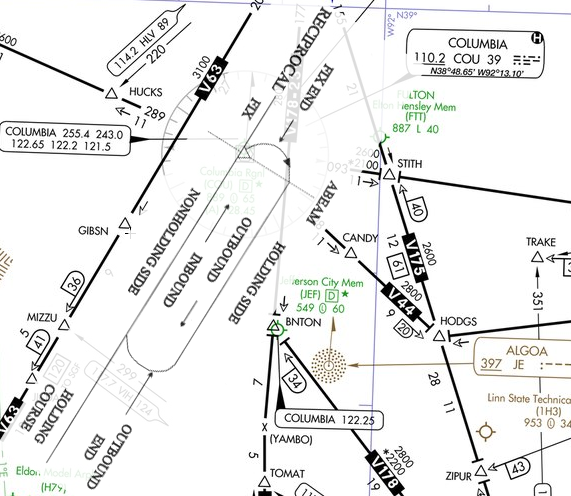There are a number of reasons air traffic control may place you into a holding pattern. Maybe unforecast weather has moved in and our destination airport is now closed to arrivals. Maybe a runway at your destination has been closed. Maybe another pilot has declared an emergency along your route. It could be some kind of equipment outage.
In addition to these reasons, it is common for holding patterns to be included in instrument approach procedures to allow pilots to align with the final approach course or lose altitude, if necessary. As we saw earlier, holding patterns may even be used in a departure procedure.
Whatever the reason, holds are always assigned and flown in about the same way. When assigned a holding pattern, the pilot is expected to stay within a designated area. We need to enter and fly this holding pattern so as to stay inside this area.
To enter a holding pattern, we first need to correctly visualize the holding pattern that has been assigned by air traffic control. In a standard holding pattern, the pilot crosses the holding fix and makes a 180 degree right turn. We would then fly outbound for one minute, before making another right 180 to join the inbound holding course back to the fix.
A holding clearance will usually begin with the air traffic control broadcast, "Cessna seven zero eight golf lima, holding, advise ready to copy." When you're ready, the controller will then give your holding clearance.
This clearance will contain the following items in order: clearance limit, direction of hold, the radial, course, bearing, or route on which to hold, leg length, turn direction, and expect further clearance time.
For example, "Cessna 708GL, cleared to Columbia VORTAC, hold southwest on the 210 radial, standard legs, standard turns, expect further clearance 1405 Zulu."
One thing that can be very confusing to instrument students is how to visualize the hold direction. When the controller told us to hold southwest, it means the holding area is located southwest of the fix. It's easy to make the mistake of thinking you are suppose to hold facing southwest, but this is wrong. You have to visualize the hold as if you are looking on a map, and place the holding pattern southwest of the fix, in this case.
When the controller told us to hold on the 210 radial, take this literally. This means your inbound leg is defined by the Columbia 210 radial, which is southwest of the VORTAC. On your inbound leg you will track the 210 radial inbound, which means setting 030 in your VOR receiver with a TO indication.
The controller stated standard legs and turns. This means we should make our turns to the right and do what we need to in order to make our inbound leg take one minute. The standard inbound leg of a standard holding pattern is 1 minute when at or below 14,000 feet. Above 14,000 feet, the standard inbound leg is 1.5 minutes long.
